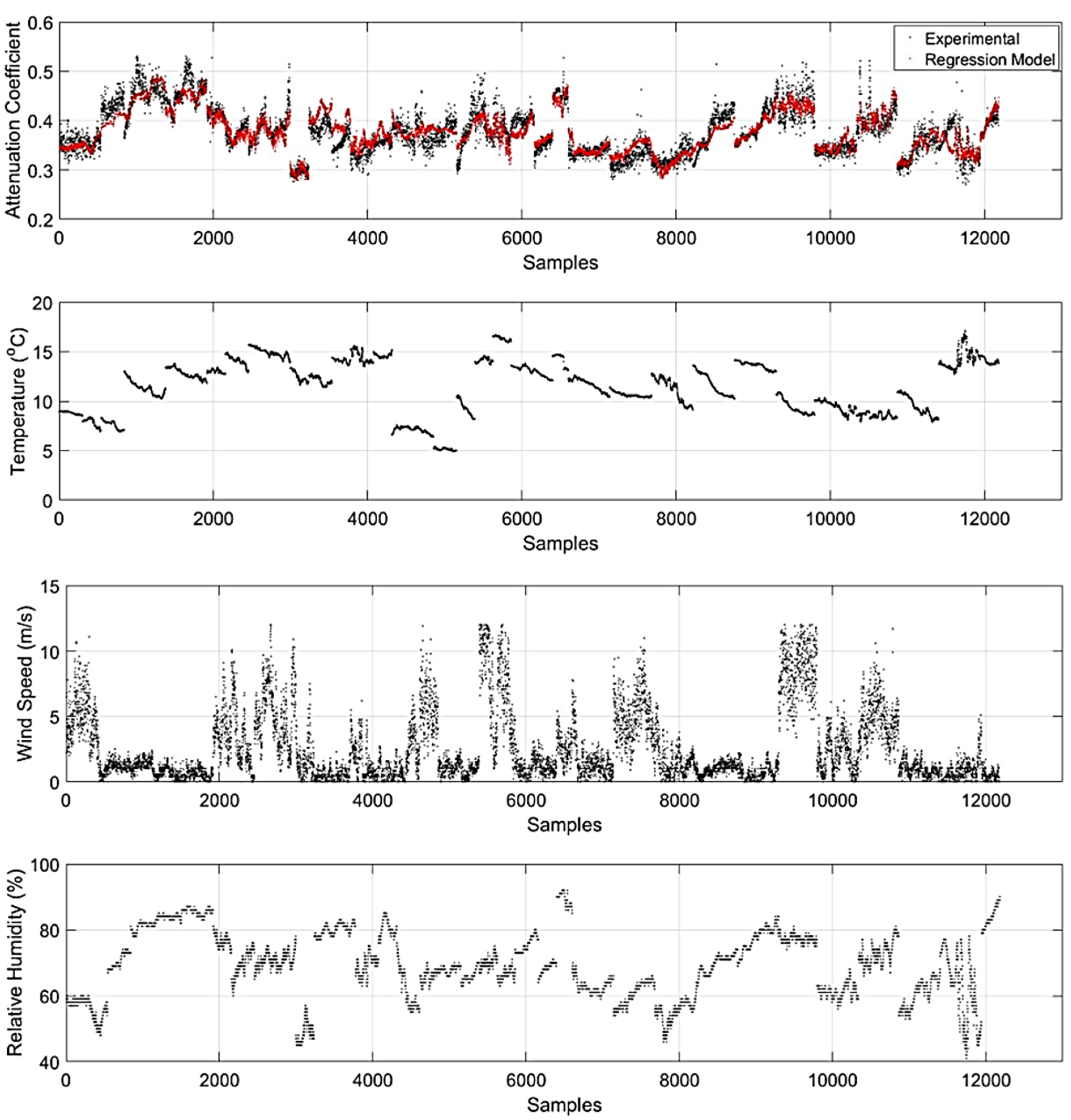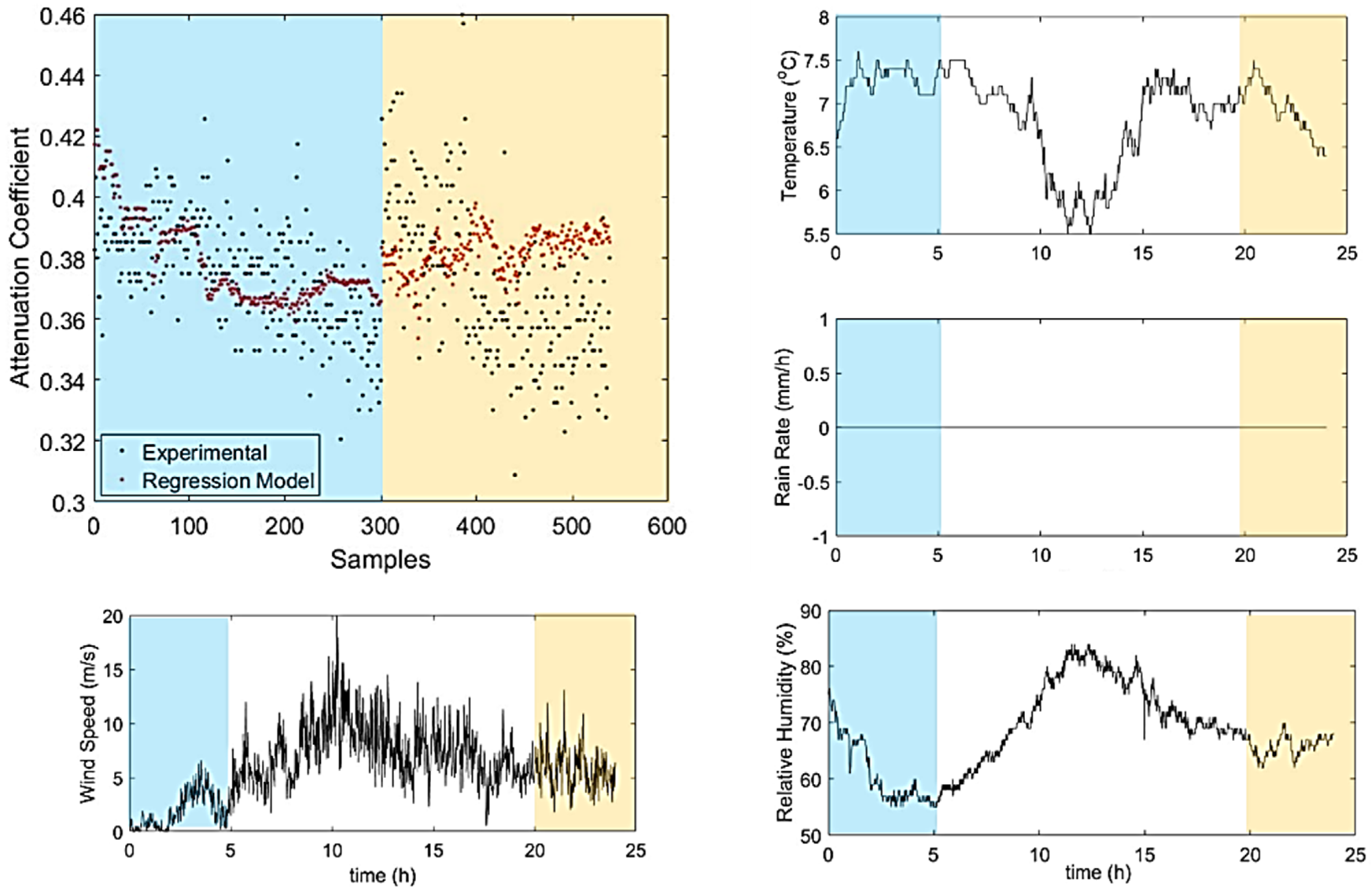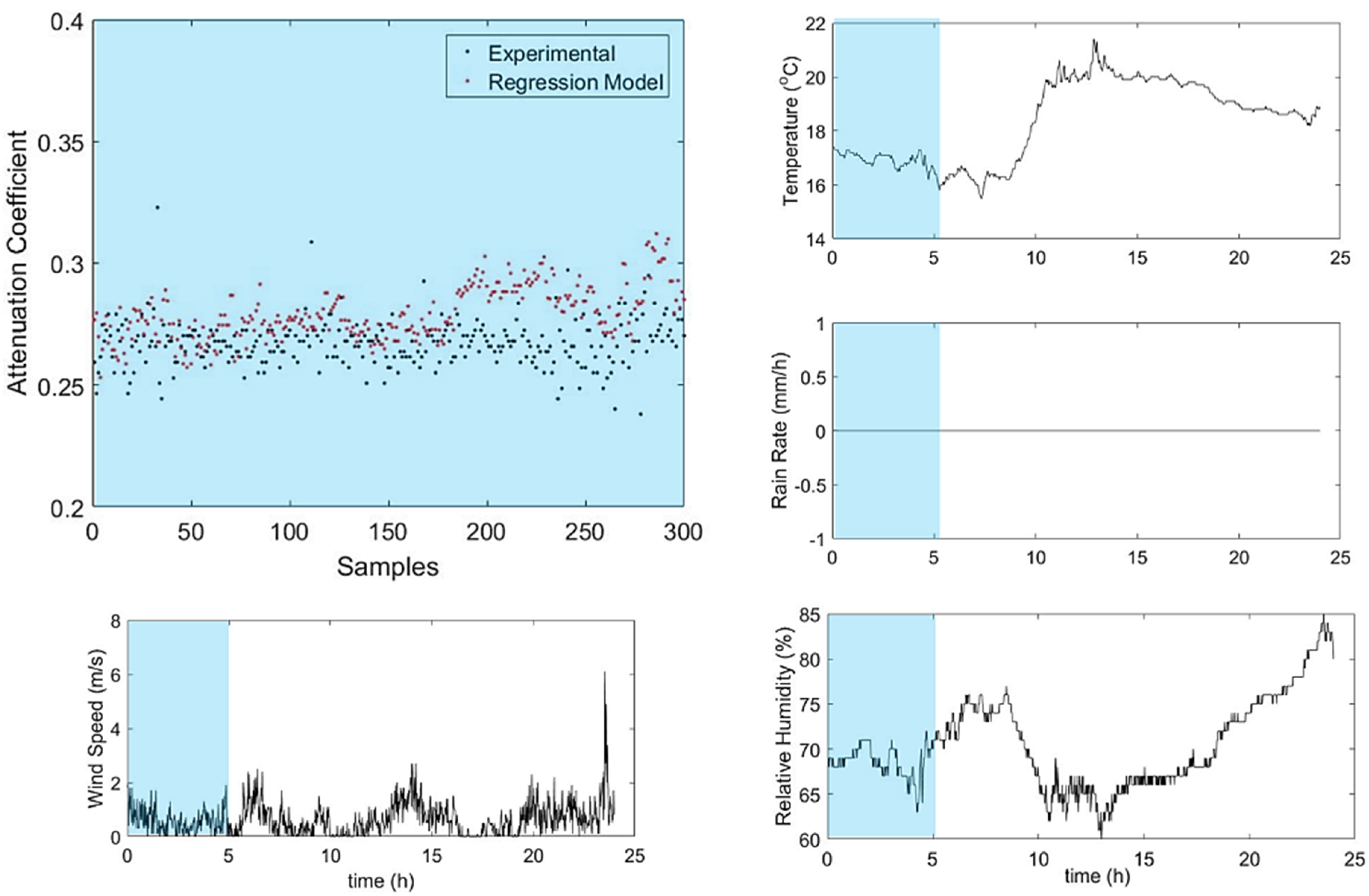4. Model Analysis and Results
By substituting the experimental values of transmitted and received optical powerin Equation (4), the experimental attenuation coefficient was evaluated. According to existing models for turbulence and attenuation in FSO systems, the main meteorological factors that affect the propagation of the laser beam were the relative humidity, temperature, and wind speed [
4,
13,
14,
18,
19]. Thus, the experimental model for the estimation of the attenuation factor would depend on these three parameters and was extracted using multiple linear regression method with the attenuation coefficient being the dependent variable and combinations of up to 3rd order values of temperature, wind speed, and relative humidity being the explanatory variables
xi [
33]:
Data collected in the first three months of the year 2020 were used for the regression process for time-periods that fulfilled the requirements of
Table 2.
In order to simplify the regression model, factors with a negligible contribution were eliminated. Thus, the estimation model for the attenuation coefficient as a function of atmospheric temperature, relative humidity, and wind speed is given through the following mathematical expression:
where
T stands for the temperature in Celsius degrees,
RH corresponds to the relative humidity, and
WS represents the wind speed in m/s. The values of the coefficients of Equation (6) are presented in
Table 3.
Taking into account the parameter values of
Table 3, the validity and the error parameters of the experimental model are presented in
Table 4.
From
Table 4, it can be seen that the coefficient of multiple correlation that is the most important parameter for the fitting accuracy of the model is close enough to one, so the accuracy of the model is high enough. Furthermore, the residual mean variance is very low, three orders of magnitude lower that the experimental measurements, a sign of high precision model.
Next, the outcomes for the attenuation factor obtained from the experiment and those that were obtained from the empirical model of Equation (6), were compared.
In
Figure 2, the experimental measurements of the attenuation coefficient according to Εquation (4) and the predicted values of the regression model of Εquation (6) were presented for 12,300 samples. It could be observed that the model that was extracted had a precise fit to the behavior of the experimental results and could predict the attenuation coefficient according to weather and atmospheric data. In
Figure 3, the experimental versus the corresponding regression model results are presented. According to the linear fitting, the slope of the curve was 0.7612 and was near to 1, as it should theoretically be, while the constant term was very low, i.e., 0.09. It could also be seen, that as the attenuation coefficient increased, the accuracy of the model decreased. This was expected because an increment of attenuation coefficient meant worse weather conditions that could not be easily modelled.
In
Figure 4, the measurements of temperature, wind speed, and relative humidity are presented for every sample that was used for the extraction of the model. It could be observed that the model has a high accuracy in case of low wind speed and relative humidity. In contrary, high values of such parameters that are responsible for very high attenuation and create fast changes in the consistency of the atmosphere, decrease the accuracy of the model. Furthermore, temperature affects the accuracy of the model in cases of very low values.
In order to more precisely investigate the behavior of the model in various weather conditions, the results of empirical model and experimental measurements are presented for specific days. In the blue box are the measurements between 00:00 a.m. to 05:00 a.m., while in the orange one are the measurements between 8:00 pm to 11:59 p.m. At the right side of the
Figure 5,
Figure 6,
Figure 7,
Figure 8,
Figure 9,
Figure 10 and
Figure 11, the wind speed and the rain rate are presented for the whole day.
In
Figure 5 and
Figure 6, the results of windy nights are presented. It could be observed that between 00:00 and 05:00 the wind was lower than 5 m/s, the model had a good fitting, while between 20:00 and 23:59, the wind was over 5 m/s with severe gusts, where the model diverged more, but was still close to the experimental measurements.
In
Figure 7, it can be observed that a lack of accuracy before precipitation took place due to unstable and fast changes in weather conditions. It was clear that the very high value of the relative humidity decreased the accuracy of the model, as the attenuation coefficient was very high. On the other hand, between 21:00 and 23:59, a few hours after precipitation and with very low wind speed where the weather conditions were mild and stable, the model presented a very high accuracy.
In
Figure 8, the results of the model are presented in cases of sudden and severe wind gusts and changes. Between 00:00 and 05:00, this phenomenon was more severe and at the same time, the relative humidity increased and the model lacked accuracy in some cases. However, as shown in
Figure 6, between 20:00 and 23:59, the model showed very high accuracy in predicting the attenuation coefficient due to mild conditions.
In order to further validate the accuracy of the model, we applied it in days that were not included in the data of the regression process. We chose days with a wide variety of weather conditions, in order to observe the models behavior, and the results are presented in
Figure 9,
Figure 10 and
Figure 11.
From the experimental measurements and the predictions of the empirical model of Equation (6), of
Figure 9,
Figure 10 and
Figure 11, it can be seen that they follow the same behavior as those of
Figure 5,
Figure 6,
Figure 7 and
Figure 8. Specifically, the model is very accurate in cases of both low wind speedand relative humidity, without precipitations and diverges in more severe weather changes. The values of
R2 for the days that were not used in the regression method for the extraction of the model are presented in
Table 6, as follows:
In
Figure 11, the FSO link was switched off for safety reasons at night, due to a ship that was expected to pass through the propagation path of the LASER beam, so only measurements between 00:00 and 05:00 were collected. Thus, the model proved to be accurate enough under specific constraints, and it could be used in order to predict the performance of FSO links, in real maritime environment, during night.
Finally, we examined the mean value and the standard deviation of the experimental attenuation coefficient for almost the same values of temperature, wind speed, and relative humidity, respectively; the results are presented in the following
Table 7.
According to
Table 7, it is clear that the attenuation coefficient mostly depended on temperature, wind speed, and relative humidity, as the standard deviation in cases of almost same values of these parameters was very low. On the other hand, the model might become more accurate if more atmospheric and weather parameters, i.e., atmospheric pressure, are investigated.



















